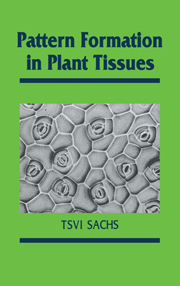Book contents
- Frontmatter
- Contents
- Preface
- 1 Introduction
- 2 Interactions of developing organs
- 3 Hormones as correlative agents
- 4 Callus and tumor development
- 5 The polarization of tissues
- 6 The canalization of vascular differentiation
- 7 Cell lineages
- 8 Stomata as an example of meristemoid development
- 9 Expressions of cellular interactions
- 10 Apical meristems
- 11 The localization of new leaves
- 12 A temporal control of apical differentiation
- 13 Generalizations about tissue patterning
- References
- Author Index
- Subject Index
7 - Cell lineages
Published online by Cambridge University Press: 05 October 2009
- Frontmatter
- Contents
- Preface
- 1 Introduction
- 2 Interactions of developing organs
- 3 Hormones as correlative agents
- 4 Callus and tumor development
- 5 The polarization of tissues
- 6 The canalization of vascular differentiation
- 7 Cell lineages
- 8 Stomata as an example of meristemoid development
- 9 Expressions of cellular interactions
- 10 Apical meristems
- 11 The localization of new leaves
- 12 A temporal control of apical differentiation
- 13 Generalizations about tissue patterning
- References
- Author Index
- Subject Index
Summary
THE DEVELOPMENTAL SIGNIFICANCE OF CELL LINEAGES
Plants are constructed from cells or divided into cells. Because of their thick walls, these cells are readily seen when tissues are magnified. Cells are units of inheritance: each one carries the entire genetic system of the organism and it is only in them that these systems are copied. Cells are also units of gene expression: within each one a type of differentiation prevails, while neighboring cells can be radically different from one another, even when they are the products of the division of one mother cell and are connected by numerous plasmodesmata (Chapter 9). The purpose here is to consider whether, or to what extent, cells and cellular events could also be units of the development of form.
From the time a cell is formed to the time it matures it can increase in volume by a factor of a thousand or more. Yet cell growth is always limited; continued development is dependent on the formation of new cells by the process of cell division. Any given tissue is thus the product of the divisions of an original, meristematic cell. Thus, a given mature cell must be the final product of a series of cell divisions, a cell lineage (Fig. 7.1). This lineage is shared to various degrees with other cells: some but not necessarily all neighboring cells are closely related ontogenetically, having originated from the same mother cell.
- Type
- Chapter
- Information
- Pattern Formation in Plant Tissues , pp. 88 - 100Publisher: Cambridge University PressPrint publication year: 1991

